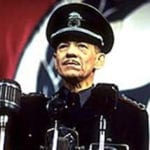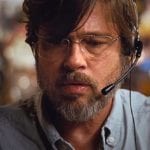 Technology
Technology  Technology
Technology  Humans
Humans 10 Everyday Human Behaviors That Are Actually Survival Instincts
 Animals
Animals 10 Animals That Humiliated and Harmed Historical Leaders
 History
History 10 Most Influential Protests in Modern History
 Creepy
Creepy 10 More Representations of Death from Myth, Legend, and Folktale
 Technology
Technology 10 Scientific Breakthroughs of 2025 That’ll Change Everything
 Our World
Our World 10 Ways Icelandic Culture Makes Other Countries Look Boring
 Misconceptions
Misconceptions 10 Common Misconceptions About the Victorian Era
 Mysteries
Mysteries 10 Strange Unexplained Mysteries of 2025
 Miscellaneous
Miscellaneous 10 of History’s Most Bell-Ringing Finishing Moves
 Technology
Technology Top 10 Everyday Tech Buzzwords That Hide a Darker Past
 Humans
Humans 10 Everyday Human Behaviors That Are Actually Survival Instincts
 Animals
Animals 10 Animals That Humiliated and Harmed Historical Leaders
Who's Behind Listverse?

Jamie Frater
Head Editor
Jamie founded Listverse due to an insatiable desire to share fascinating, obscure, and bizarre facts. He has been a guest speaker on numerous national radio and television stations and is a five time published author.
More About Us History
History 10 Most Influential Protests in Modern History
 Creepy
Creepy 10 More Representations of Death from Myth, Legend, and Folktale
 Technology
Technology 10 Scientific Breakthroughs of 2025 That’ll Change Everything
 Our World
Our World 10 Ways Icelandic Culture Makes Other Countries Look Boring
 Misconceptions
Misconceptions 10 Common Misconceptions About the Victorian Era
 Mysteries
Mysteries 10 Strange Unexplained Mysteries of 2025
 Miscellaneous
Miscellaneous 10 of History’s Most Bell-Ringing Finishing Moves
Top 10 North Korean Propaganda Films
During his reign, North Korean dictator Kim Jung Il was so interested in propaganda through movies that he even wrote a book, On the Art of The Cinema. In it, he describes his tactics of using movies as an educational tool to spread his ideals to the nation. One of the steps in his process of making high-quality films was ordering his secret service to kidnap directors, actors, and other talented artists from South Korea so they could bring his ideas for movies to life.
While the plots of these movies vary greatly, they are all forms of propaganda designed to keep the public believing in their Great Leader and the morals of society that they are expected to follow.
10Pulgasari
The South Korean director Shin Sang-Ok was one of the kidnapped directors brought into North Korea, and he was forced to direct a rip-off of the Japanese movie Godzilla, called Pulgasari.
The movie takes place in feudal Korea. Rich nobles loot a farming village and imprison an innocent elderly blacksmith. His children give him rice through the bars. Instead of eating it, the blacksmith molds the rice with his daughter’s blood until it turns into a miniature figurine of a monster. With his dying breath, he asks the gods to use his spirit to rescue the farmers from the monarchy.
The figurine of the monster, Pulgasari, has come to life, and it eats iron for food. The more metal it consumes, the bigger and stronger it grows. It soon becomes indestructible against any attacks. With the help of Pulgasari, the farmers are set free from the nobility’s rule. At the end of the movie, Pulgasari becomes enormous. While the villagers dearly love the monster for saving them, he cannot satiate his hunger for iron.
The blacksmith’s daughter realizes that if Pulgasari cannot stop consuming all of the iron, he will cause starvation and war. She sacrifices herself for the good of her country, committing suicide to banish the Pulgasari back to the spiritual world. This is meant to be an allegory of the dangers of capitalism. North Koreans must stop it from taking over, even if it means sacrificing one’s own life.
9The Favorite Young Man
The main character, Kim Yong Bae, is handsome, friendly, intelligent, and a talented army veteran. Despite all of his obvious potential, he happily works hard at the humble job of a plumber. He runs into his old friend Son Ae, a beautiful, kind woman who works as a tailor, and they fall in love. Son Ae’s family tells her that she is too good to be with a plumber.
Son Ae declares that she does not care about his job, because she only cares about who he is as a person. Eventually, her family is won over by Kim Yong Bae’s personality as well. By the end of the movie, every single person who talked down on his job as a plumber has changed their mind. He even saves the entire town when pipes burst.
In the North Korean communist society, capitalism and private wealth is forbidden. Working hard and being satisfied with the jobs the government chooses for you is always encouraged, especially for the lower classes of society. At several points in the film, Kim Yong Bae stares directly in the camera, talking about the importance of plumbers in society for supplying clean water. The camera zooms in, practically breaking the fourth wall. It is as if he is scolding the audience and shaming anyone who talks down on the importance of blue collar jobs. The film is technically a romantic comedy, but that becomes a minor part of the movie compared to the lesson that the film is trying to teach North Korean citizens.
8My Socialist Country
This documentary is voiced over in English, aiming to educate other countries about life in North Korea. It claims North Korean people have everything they could ever want provided for them: food, clothing, housing, healthcare, jobs, 150 days of maternity leave, and even a free college education. Somehow, even without charging their citizens taxes, this country apparently manages to pay for the needs of all of the people. My Socialist Country presents North Korean life as though the communist system is running perfectly in isolation from the outside world, and everyone should envy those who live there.
If someone were to watch this movie without understanding the reality behind it, they would be convinced that North Korea is an amazing utopia.
7Eternal Comrades
In 1946, a terrorist group tried to kill Kim Il Sung. A Soviet officer named Yakov Nevichenko saw the grenade and sacrificed himself by throwing his body on top of it, saving Kim Jung-Il’s life. It turns out that Nevichenko had a very large book strapped to the front of his chest as a primitive form of body armor. This was enough to save his life own life as well, though he sustained multiple injuries, including losing his arm. After that, Nevichenko received the title of North Korean National Hero, and there was even a statue made in his honor.
Eternal Comrades reenacts the events of that day, leading up to the relationship built between the Soviet Union and North Koreans. The movie is meant to show North Korean audiences that their Great Leader is worth sacrificing their lives for, even to the extent that foreigners would do the same. “Yakov” became a popular baby name in North Korea after this incident.
6Soul’s Protest
Soul’s Protest premiered only three years after the American hit film Titanic, in an attempt to replicate the box office success. Soul’s Protest tells the true story of the sinking of the ship Ukishima Maru in 1945. Onboard, Korean passengers were returning home from forced labor camps in Japan.
According to records, the boat exploded when it hit a hidden landmine in the ocean. 524 Koreans died, and the Japanese did not give any compensation to the survivors of the sinking ship. They claimed that it was an accident that could not have been avoided. However, North Koreans have been digging into the case to blame the Japanese for sinking the ship on purpose. Though the rumor was disproven in court, this movie assumes that that conspiracy theory is true, and the Japanese were trying to cover up using Koreans for forced labor by killing them off at sea.
While this movie is loosely based on true events, it is clearly meant to incite hatred toward the Japanese, who, along with Americans, are North Korea’s sworn enemies. The director, cast, and crew were required to watch Titanic over 100 times in preparation for the film. There are a lot of little homages to the film, and scenes that look like drama school reenactments. However, instead of steamy love scenes, the lovers of Soul’s Protest simply smile at one another in a very polite way.
5The Flower Girl
Based on an opera and novel, The Flower Girl tells the story of Koreans living under Japanese occupation in the 1930s. The main character is a girl who must climb the mountains, picking flowers every day to sell them in the market. Her mother is very sick, her younger sister is blind, her father is dead, and her brother is away fighting as a revolutionary soldier. Despite being too sick to work, the landlord shows no sympathy for the mother and demands to put them out on the street if they don’t pay their rent.
No matter how hard she works, the young woman cannot afford to buy her mother the medicine to cure her. Eventually, the mother succumbs to her illness and dies. The blind sister cries inconsolably. The landlord is tired of listening to her crying, so he claims that she is possessed with the dead mother’s spirit and needs to be killed to “exorcise the demon.” The flower girl no longer has a place to stay, and must suffer even more and more throughout the movie. Her brother returns from the war, and Korea wins its independence from Japan.
This movie’s goal was to show North Koreans exactly how terrible life was before communism, where they get provided free health care and housing. This movie is considered to be the most famous and successful North Korean propaganda film, because the acting is very well done, and it brings up a lot of emotions for anyone who watches it, no matter what country they live in.
4O Youth!
This movie shows the life of a North Korean family with five daughters who are all professional athletes and one son. The son is a historian still living with his parents while he works on his PhD thesis. Since he is nearly 30 years old and still single, the mother desperately worries about him finding a wife. The son meets a woman in the library. He begins courting her and thinks that she is a bookish sort of girl, but in reality, she is a professional Taekwondo fighter.
The movie features the sports complex in Pyongyang that was built by Kim Jong Il. The characters talk about the glory of their Great Leader and how much he appreciates young athletic talent. Once the son and mother hear about this, they are so emotionally moved that they begin to appreciate sports as well.
At one point in the movie, the young couple is getting hassled by a gang of men, when the girlfriend saves them both by fighting them off with her Taekwondo. Once her athletic side is revealed, he asks her to look over his History of Taekwondo Thesis for his PhD. Her suggestion is that he needs to give more credit to the Great Leader, because without him, the sport would not be the same.
3Welcome Of North Korea
This English voiced-over video was created in the 1980s to encourage foreign tourists to visit North Korea. The country looks like the citizens live in economic abundance, with large buildings, beautiful clothes, and plenty of food to eat. Foreigners are brought to acrobatic shows, gift shops, historic buildings, and beaches. Anyone watching this video would assume that North Korea is a great place to live, and negative rumors must not be true.
Today, the tours given to tourists are very similar in nature, except that they have added a few newer, modern attractions, like water parks and a technology center. Tourists who enters the country are never allowed to be left alone at any time, and they must show respect to The Great Leader. If you are interested in seeing what tourists in North Korea are allowed to see today, filmmaker Louis Cole documented his time in the country on his YouTube Channel, FunForLouis.
2Order No. 27
North Korean soldiers must go on a secret mission. They understand that it’s extremely dangerous, but they gladly accept the opportunity to serve the Great Leader.
The entire movie plays out like it’s supposed to be a parody, yet it is very serious. Every battle looks like something out of Mortal Kombat. North Korean soldiers look incredibly skilled to a superhuman extent. To anyone watching from the Western world, Order No. 27 is hilarious and kind of tragic at the same time.
Maybe this movie was filmed to make North Koreans, who are all required to receive army training, excited to possibly enter an actual battle someday. Or maybe Kim Jong Il hoped that other countries would see it the film and somehow believe that every Korean solider is a Kung Fu master.
By the end of the movie, the soldiers can complete their mission, but a few of their friends died along the way. Unlike American war movies, all of the men, even their commanders, openly cry at the loss of their fellow soldiers. The last lines of the movie explain that “when a soldier dies for the Great Leader and the Communist Party, their lives become eternal in the minds of our people.”
1Under The Sun
This 2015 documentary film was a project started by Russian director Vitaly Mansky. He wanted to do a documentary on life in North Korea, so after years of negotiating, they allowed him access—but only if he filmed everything the government asked him to. He realized that everything in the lives of the people he was “documenting” was staged, and they wanted to use Mansky to make a propaganda film. Their intentions backfired when Manksy chose to leave the camera rolling as much as possible and left the outtakes in the final cut, so that the world could see exactly how people are treated, and how much of the country’s good life is orchestrated.
In one scene, Mansky is brought to a factory. They walk through stairs and hallways, and everything looks completely vacant, except for the few rooms that are set up with machinery. Men and women, who we learn are actors who usually work completely different jobs, are asked to play the parts of factory workers. Their lines are about how to improve production and the success of their work. Between takes, we see women bundling up with their jackets, which shows that the factory does not have any heat, even in the middle of winter.
Obviously, the North Korean government was not happy with this movie and banned it from being show in their country. However, Under The Sun has received multiple awards in other parts of the world.
Shannon Quinn is a writer and entrepreneur in the Philadelphia area. If you are interested in more of her work, you can find her here.








